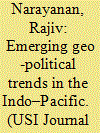| Srl | Item |
| 1 |
ID:
170764


|
|
|
|
|
| Summary/Abstract |
The Indo-Pacific Region (IPR) is witnessing a major flux in the geo-political and geo-strategic spheres as there is a gradual shift in the maritime trade centre of gravity towards IPR from the Atlantic and the Pacific Regions. With the West and the USA perceived to be in a strategic retreat, it opens a window of opportunity in the region for a geo-strategic reconstruct. China, the resident major power, is keen to seize this opportunity to gain influence in the region. Xi Jinping sees this geo-political flux as an opportunity for China to assert itself within the Indo-Pacific. Towards that end, he has clubbed the existing infrastructure projects, and added a few, under the much touted ‘Belt Road Initiative (BRI)’ with the aim of gaining geopolitical space in Asia.
The article provides an analysis of the US and the Chinese strategies and the emerging trends for the Indo-Pacific and their implications for India and the way ahead.
|
|
|
|
|
|
|
|
|
|
|
|
|
|
|
|
| 2 |
ID:
170695


|
|
|
|
|
| Summary/Abstract |
The article seeks to explain why Singapore—a high-income, developed economy that does not require massive external financing or technical assistance for domestic infrastructure building—has repeatedly endorsed Belt-and-Road Initiative (BRI) and cooperated in related projects. Given the city-state’s exceptionally high degree of economic openness and hence dependence on international trade, it argues that Singapore’s support for BRI is driven primarily by its quest for strategic relevance. Lacking natural resources and an economic hinterland, the small trading state has pursued state-guided development, establishing itself as a key regional and global trading hub. Singapore’s economic goals thus correspond to BRI’s objective of improving Eurasian connectivity and strengthening trade and investment ties. At the same time, however, the city-state is also pursuing a hedging strategy vis-à-vis China. Singapore seeks to ensure no one major power dictates the economic terms in the region. The city-state hence seeks to both socialize Beijing in the norms of the existing regional architecture through engagement, while also emphasizing economic relations with other countries, especially the USA. Unlike most of China’s other BRI partners, Singapore is not a recipient of investments, but rather a case of “reverse BRI flow”: Singapore is investing in the development of China’s western region, especially Chongqing. Singapore’s support for BRI is likely to continue, even though the state may encounter obstacles along the way, such as the need to manage the effects of growing Sino-US rivalry.
|
|
|
|
|
|
|
|
|
|
|
|
|
|
|
|